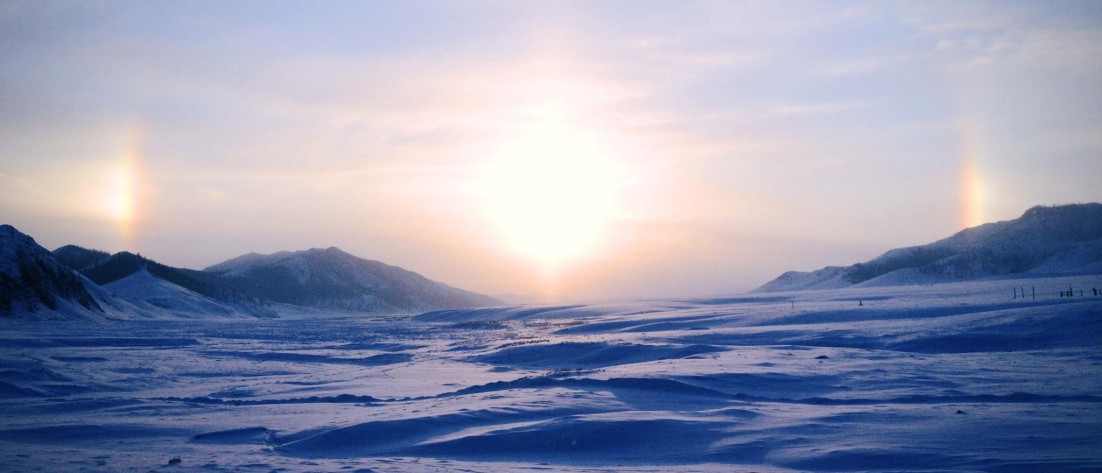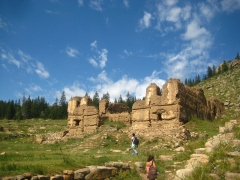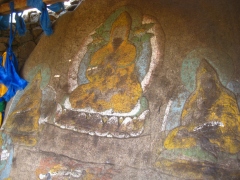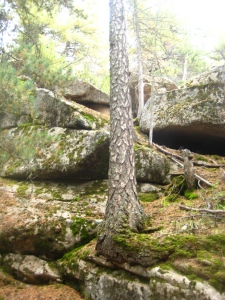At long last, the sky began to grey, and then to brighten, and though the trees and mountains blocked direct light as well as any view of the sunrise, we were all awake by dawn. We ate the last of our food and sipped at our precious water reserves, wishing desperately for coffee or hot chocolate, something to banish the chill from our bones.
As we extinguished the last of our fire with yet another chunk of moss, I smiled wryly at the other girls. “Well, I hadn’t expected to teach Wilderness Survival Merit Badge on this hike,” I said, eyeing our shelter through the final wisps of smoke, “but congratulations. You all pass.” They chuckled and finished got to their feet, donning their packs.
We weren’t out of the woods yet, literally or figuratively, but we’d made it through the night. Now we had to get home.
(New to this story? Click back to read Part I and Part II of our rather disastrous hiking trip.)
Unfortunately, getting home was not going to be easy. Though we set off chilled and aching, we hadn’t been walking long before we started stripping off our extra layers as we clambered through field after field of boulders. Dehydrated as we were, and without enough water to remedy the problem, we overheated quickly and stayed that way. The exhaustion of the previous day’s hike and general lack of sleep had taken its toll as well, and our progress toward the distant city we caught in tantalizing glimpses was slow. But we were making progress, at least, and so we trudged onward, making our careful way downhill.
As usual, I’d fallen behind the others during this downhill stretch, and so at first I didn’t see anything different about their having stopped ahead of me; it just looked like another break. But as I approached, the depressing truth appeared: though compass and city lights told us to keep marching forward, we’d have to disregard their beckoning and turn aside. We’d trudged straight into a barbed-wire fence.
RESTRICTED AREA – DO NOT ENTER, declared the signs posted at regular intervals. Moreover, they said so in English as well as Mongolian, which I found entertaining; very few signs in this country boasted translations. Why bother here, when the barbed wire shouted stay out in a universal language?
Having made extensive use of our guidebooks, we knew where we were now, and it was not where we wanted to be.
Be careful not to drop too soon or you’ll end up at Ikh Tenger, one valley short of Zaisan. Ikh Tenger is where the president lives with machine gun-wielding guards, who will be none to pleased if you drop by unannounced. If you see a barbed-wire fence you are in Ikh Tenger; to get out, just continue west along the fence and over the next ridge.
So we did as the book advised: we turned left and tried our best to follow the fence west. Alas, it mostly didn’t go west – we were forced to backtrack as it turned ever more south, leading us up a ridge and through brambles tore at our hands and arms. We paused as we trudged through to strip them of raspberries and rose hips, exacting our small revenge. Up and back, up and back we climbed single file, warning the others as we encountered bad footing. Despite our care, Krysta and I both slipped and fell into rosebushes, while Valerie went sliding into a brush-filled hole. We took the setbacks as best we could, giggling at the falls and grateful that none of us sustained injury.
At last, we were able to continue northward along the side of the ridge the fence has led us to. Abruptly, we found ourselves out of the woods and in the merciless sun. This ridge was desert-like, covered in gravel and larger stones – the kind of surface that sends you sliding back a step and a half for every two you try to take uphill, or jerks your feet out from under you altogether when you’re waking your way down. We considered our options: up, down, or across? I left the others to make my slow way uphill, but when the long journey up a hundred feet left me far from the top, we decided to try our luck amongst the forested base of the ridge. We could make our way between ridge and woods, we figured, at the border where the brush wasn’t too thick.
We seemed to be in luck. Upon reaching the base of the ridge, we found ourselves upon a path – a path! – that followed a little stream. The barbed wire appeared to have receded back into the woods; there was none in sight, but visibility into the thick tangle was limited. As we followed the path, a ger appeared before us, bringing smiles to our tired faces. At long last, we were nearing civilization.
But as we approached, Ginny noted that it was an awfully nice-looking ger – nicer than you’d expect from a family squatting near the presidential compound. As the ground before us cleared, we found that it had been erected, not on grass, but on astroturf, which I’d seen only once or twice in this country. Sensing that, despite our best intentions, we had found ourselves somewhere we were not supposed to be, we made to turn back to the ridge.
And that was when we saw the man with machine gun.
He’d been walking at an angle to us originally, following a path we couldn’t see, but he stopped when the five of us caught his eye. He looked at us, and we looked at him, and when he started in our direction, the five of us walked to meet him without a word. What else could we do? You don’t run from men with machine guns.
In our limited Mongolian, we apologized. “Passport?” he demanded, though of course none of us had them. I handed over my photocopy, and the others driver’s license or student IDs. He radioed a partner and led us away – where, we didn’t know. He asked if we spoke Mongolian, and I answered, “a little.” But that was the end of the conversation. No questions, no explanations. But at least we weren’t made to enter any of the buildings we past, some of which had no windows.
As we walked, I tried to prepare an explanation despite not knowing any of the key words – hike, trail, lost. The best I could come up with was something like, Yesterday we went to Zun Mod. We saw monastery and then wanted to walk to UB. We saw road and walked and then didn’t see road. So we slept outside. Today we walked to here. We want to go to UB.
We stopped along a road as the guard escorting us waited for another to join us. Despite our exhaustion, we were not allowed to sit, nor did we have the nerve to press the issue. The next guard again asked for our passports, which we once more explained were at home. V produced a business card the new Fulbrighters had been given in case of emergencies, one that said in Mongolian, “Take me to the US Embassy.”
The second guard considered the card and held onto it, leading us to building alongside the main gate. He entered and told us to wait outside, so we took seats along the curb. There was the road to the city – just a few feet away, but separated from us by a tall, spiked fence. Unlike the pack of stray dogs that raced by, we could not simply slip between the black bars that stood between us and our destination.
Finally, they led us into a room with a single couch and told us to sit. It was a tight squeeze for the five of us, but we sank into it gratefully. More waiting ensued. It had been at least an hour since we’d stumbled into the compound, and who knew how many more would pass before we’d be allowed to leave it.
My ringtone broke the silence.
“Hey, what’s up?” my friend asked when I picked up the phone.
“Funny you should ask,” I replied, without really answering. “And I’m sorry, but I’m not sure when I’m going to be able to meet you today.”
“Why’s that?” she asked; I briefly explained where I was. “The president,” she repeated dubiously. “The president of what? of MONGOLIA?!”
I murmured my assent.
“What the F**K, Katelin!” she shouted in my ear.
I winced. “Listen, it’s a long story, but I’d be happy to tell you later – when I’m not, you know, being detained for trespassing on the presidential grounds.”
Another phone rang shortly thereafter. We all exchanged nervous glances when the name came up – it was the Public Affairs Officer for the US Embassy.
Finally, Alisa volunteered to take the call. More explanations of where we were and how we’d gotten there, peppered with frequent apologies. We’d received a call from the Duty Officer night before and had been dismayed that our friends in UB had thought it necessary to call the Embassy; it seemed like overkill. Now, however, we were glad that our friends there had been apprise of our trip and surprise overnight, as it helped them to explain our current predicament to the guards detaining us.
We sat quietly for awhile more after Alisa had finished apologizing to the Embassy folks for the inconvenience we were causing them, but eventually, a guard came in to see us. He demanded our cameras and looked through them to make sure we hadn’t taken pictures of anything we weren’t supposed to. He also examined our bags, confiscating my pocket knife when he came across it at the bottom of mine.
After another hour of waiting, the Duty Officer finally arrived to pick us up; we weren’t allowed to leave on our own. I asked if I could have my knife back, but was denied – apparently they’re not allowed in restricted areas. I was bitter at the loss; it was a good knife that had served me several years, and it wasn’t like I’d brought in a machete. But I tried to keep it in perspective as we climbed into the Duty Officer’s car and exited those dreadful gates, our adventure coming to a close at long last. No one had been killed or injured; though our hike had taken more than twice as long as the guidebook had indicated, we’d never gotten truly lost; despite wandering into truly forbidden ground, we hadn’t been arrested.
“Well?” I had asked the others over an hour earlier, before we knew when – or if – we’d be allowed to leave. “Would you do it again? Was it worth it?”
“Absolutely,” said Krysta with a smile, while the others nodded in agreement. “But next time, we’ll bring a tent.”















